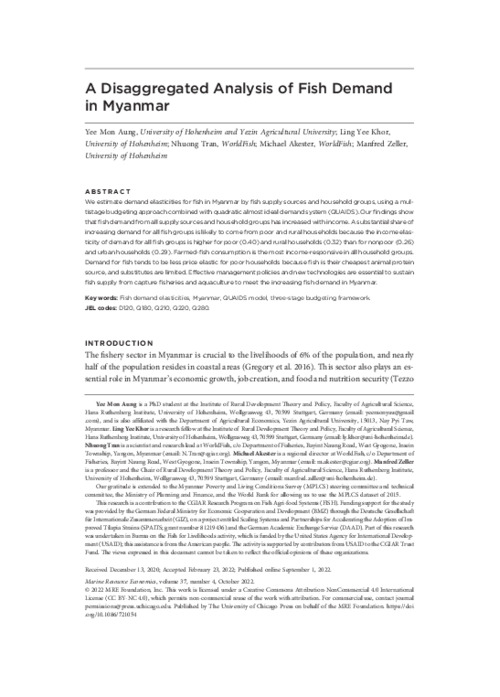Please use this identifier to cite or link to this item:
https://hdl.handle.net/20.500.12348/5298
A Disaggregated Analysis of Fish Demand in Myanmar
| dc.creator | Aung, Y.M. | en_US |
| dc.creator | Khor, L. | en_US |
| dc.creator | Tran, N. | en_US |
| dc.creator | Akester, M.J. | en_US |
| dc.creator | Zeller, M. | en_US |
| dc.date.accessioned | 2022-11-08T13:41:10Z | |
| dc.date.available | 2022-11-08T13:41:10Z | |
| dc.date.issued | 2022 | en_US |
| dc.identifier.citation | Yee Aung, Ling Khor, Nhuong Tran, Michael Akester, Manfred Zeller. (4/10/2022). A Disaggregated Analysis of Fish Demand in Myanmar. Marine Resource Economics, 37 (4). | en_US |
| dc.identifier.issn | 0738-1360 | en_US |
| dc.identifier.issn | 2334-5985 | en_US |
| dc.identifier.uri | https://hdl.handle.net/20.500.12348/5298 | |
| dc.description.abstract | We estimate demand elasticities for fish in Myanmar by fish supply sources and household groups, using a multistage budgeting approach combined with quadratic almost ideal demand system (QUAIDS). Our findings show that fish demand from all supply sources and household groups has increased with income. A substantial share of increasing demand for all fish groups is likely to come from poor and rural households because the income elasticity of demand for all fish groups is higher for poor (0.40) and rural households (0.32) than for nonpoor (0.26) and urban households (0.29). Farmed-fish consumption is the most income-responsive in all household groups. Demand for fish tends to be less price elastic for poor households because fish is their cheapest animal protein source, and substitutes are limited. Effective management policies and new technologies are essential to sustain fish supply from capture fisheries and aquaculture to meet the increasing fish demand in Myanmar. | en_US |
| dc.format | en_US | |
| dc.language | en | en_US |
| dc.publisher | The University of Chicago Press | en_US |
| dc.rights | CC-BY-NC-4.0 | en_US |
| dc.source | Marine Resource Economics;37,(2022) | en_US |
| dc.subject | fish demand elasticities | en_US |
| dc.subject | three-stage budgeting framework | en_US |
| dc.subject | quaids model | en_US |
| dc.title | A Disaggregated Analysis of Fish Demand in Myanmar | en_US |
| dc.type | Journal Article | en_US |
| cg.contributor.crp | Fish | en_US |
| cg.contributor.funder | German Federal Ministry for Economic Cooperation and Development | en_US |
| cg.contributor.project | Scaling systems and partnerships for accelerating the adoption of improved tilapia strains by small-scale fish farmers | en_US |
| cg.coverage.country | Myanmar | en_US |
| cg.coverage.region | South-Eastern Asia | en_US |
| cg.subject.agrovoc | myanmar | en_US |
| cg.subject.agrovoc | Fish | en_US |
| cg.contributor.affiliation | University of Hohenheim | en_US |
| cg.contributor.affiliation | WorldFish | en_US |
| cg.contributor.affiliation | Technical University of Munich | en_US |
| cg.identifier.status | Open access | en_US |
| cg.contribution.worldfishauthor | Aung, Y.M. | en_US |
| cg.contribution.worldfishauthor | Tran, N. | en_US |
| cg.contribution.worldfishauthor | Akester, M.J. | en_US |
| cg.description.theme | Sustainable aquaculture | en_US |
| dc.identifier.doi | https://dx.doi.org/10.1086/721054 | en_US |
| cg.creator.id | Nhuong Tran: 0000-0002-1813-4571 | en_US |
| cg.creator.id | Michael Joseph Akester: 0000-0001-6526-1613 | en_US |
Files in this item
This item appears in the following Collection(s)
-
Sustainable aquaculture [2738]
